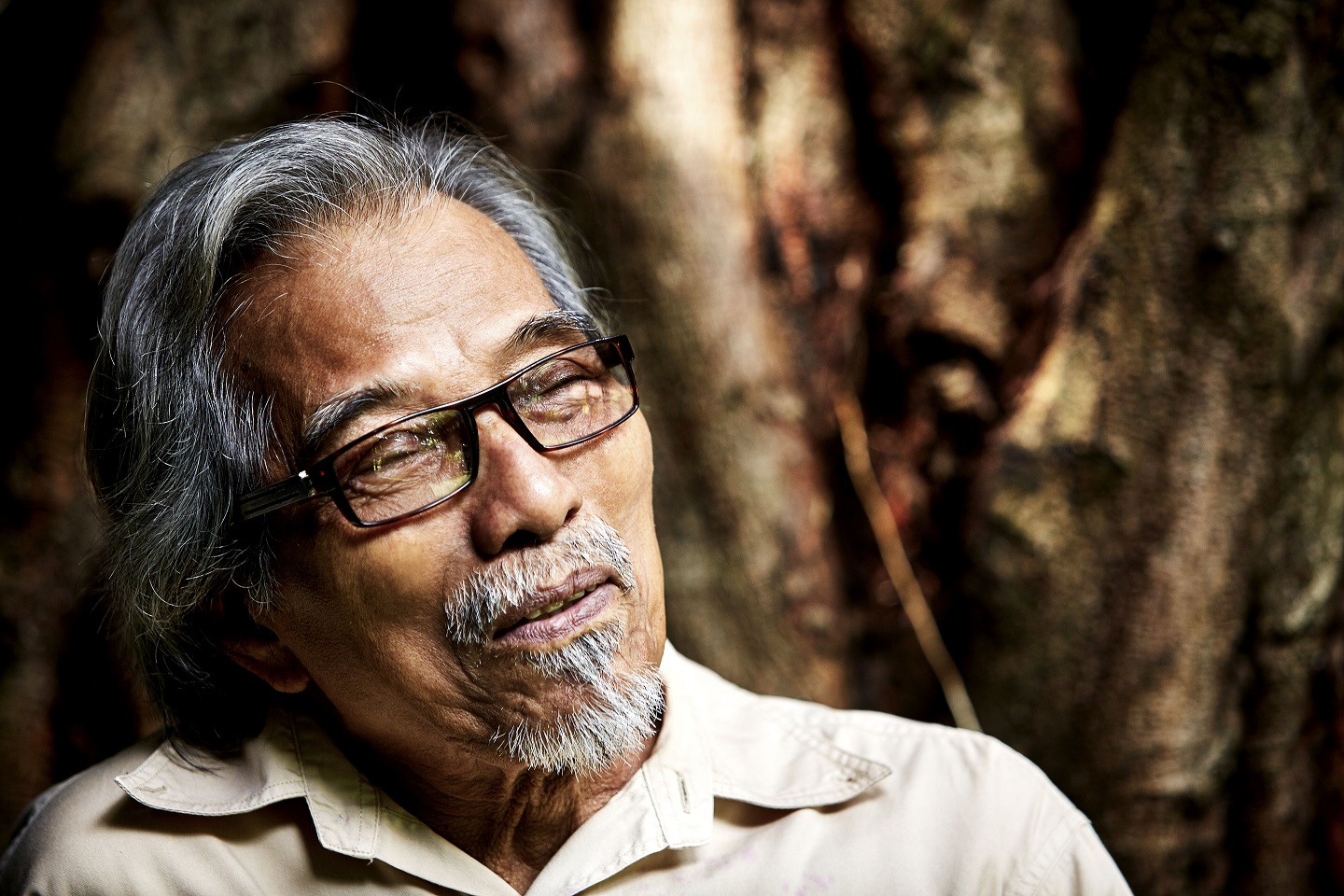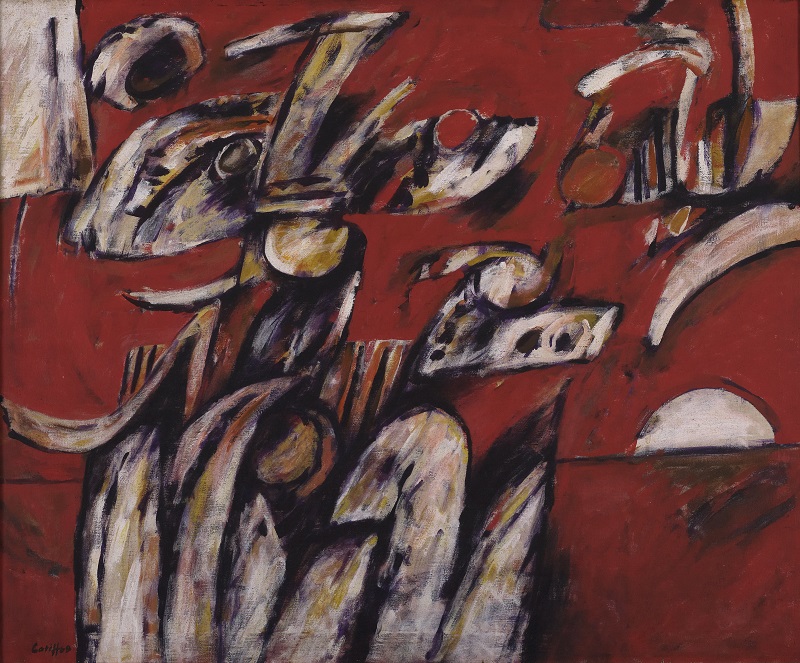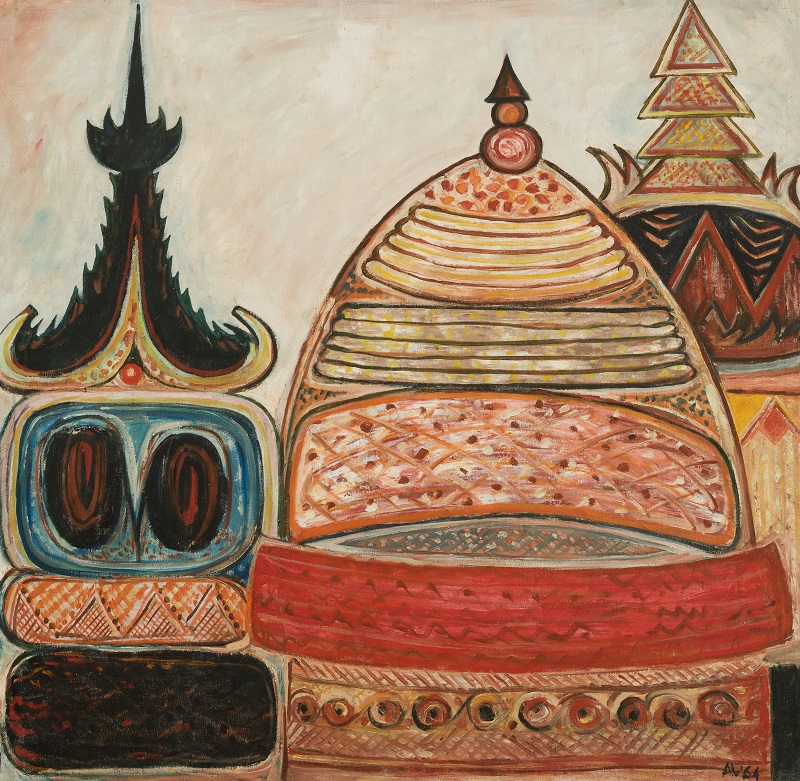
(Photography by SooPhye)
Latiff Mohidin’s Pago Pago series was hailed as unique and exemplary the moment it appeared in public. It was seen as a compelling family of pictures in 1973, when the Balai Seni Lukis Negara (as it was then known) staged a retrospective exhibition of the artist in Kuala Lumpur, spanning about 20 years of his art. In this show, works bearing “Pago Pago” and its variations in their title were the most numerous and they were set apart from his earlier and current productions by their powerful imagery, forceful composition and arresting symbolic as well as visual presence. Since then, the title has served to distinguish a group of works that is critically esteemed and aesthetically cherished.
Produced in the 1960s, the pictures still appear in exhibitions until today — sometimes solo, at times in the company of other artists and at other times in relation to topics and themes that encompass extensive artistic and historical terrains. In all these instances, Pago Pago commands particular attention and acclaim.
Since the series debuted, it has never faded from view. So much so that Pago Pago and Latiff are inseparable — one defines and is defined by the other. A measure of its impact is gained by recalling the 1973 show. While Pago Pago pictures were the most prevalent, a number of works bearing the title Mindscape were displayed but they were barely noticed, though they were compelling in a different way. These works signalled current developments in Latiff’s art practice and marked decisive departures from Pago Pago that constituted a new series. Pago Pago was, at the time of the 1973 show, creatively over and done with.

Pago Pago is not only seen, it is written and read about in publications. It pulsates in Latiff’s thoughts and in his writings. He deals with it poetically, philosophically, autobiographically, historically and aesthetically. And he deals with it continuously. It is prominent in discussions by writers when writing on Latiff’s art and on modern art and artists in Malaysia. From time to time, it is featured in representations of modern Southeast Asian art, when it is seen as marking a significant attainment in Latiff’s practice while pictorially embodying Southeast Asia.
It is in this spirit that we read the late Redza Piyadasa’s appraisal, which was published for the retrospective show in 1973. He wrote that Latiff “drew his inspiration from the most ordinary forms in the region. It was really a ‘regional’ involvement rather than a specifically ‘Malaysian’ one and in that sense Latiff is really a ‘Southeast Asian’ artist”. (Piyadasa, Abdul Latiff, ‘The Artist — An Appreciation’, A Latiff. Retrospective Exhibition, Balai Seni Lukis Negara, Kuala Lumpur, 1973.) Accordingly, resources for his art are cultivated by studying the natural and cultural forms in the region — his art is recognisable as of the region. The artist is transposed from bearing national affiliations or identities into assuming a stature that artistically manifests the region (Southeast Asia).
The positioning of artists in diverse locations — the circulation of artworks around varied and competing sites, be they national, regional, global or combinations of any of these — springs from the ambitions and initiatives of public (national) and corporate agencies. Artists are vital players in deciding on destinations and residencies for advancing their art territorially. The current exhibition at the Centre Pompidou in Paris — Latiff Mohidin: Pago Pago (1960-1969) — bears vivid testimony to these decisions and movements.
“Latiff is really a ‘Southeast Asian’ artist”, said Piyadasa (it appears rhetorically within the standfirst for my text). Compelling as his statement is, it was not the first and only one.

In 1964, for instance, Latiff displayed a number of Pago Pago pictures in Bangkapi Gallery, Bangkok, when the compositions, recognisable today as forming this series, were being developed and were seen in their formative stages. Hiram Woodward Jr, who has produced a substantial body of art historical studies of Hindu-Buddhist sculpture in Southeast Asia and especially of Buddhist art in Thailand, published a review of this show. He was serving at the time as a US Peace Corps volunteer in Thailand, and had begun to cultivate interest in the history and artistic cultures of this kingdom. What he said is pertinent to our discussion and it remains largely unknown.
Woodward greeted the exhibition enthusiastically. He set Latiff apart from the Thai artists. Whereas the latter tend to create worlds that are harmonious, consisting of pictures in which forms and imagery are integrated, settled and, we presume, somewhat tepid, Latiff executes his pictures vigorously. His forms rise assertively. They forcefully intersect and vie with one another for dominance. His compositions project worlds made up of “opposing forces and violent ends”, said Woodward, “everywhere there is variety and opposition”. In his view, Latiff’s show in Bangkapi Gallery signalled a “splendid intrusion of fresh ideas in the Bangkok art scene”.
When he examines the imagery, especially in the Pago Pago series, Woodward detects the sources for their formations. He listed “batik design, Moslem architecture, primitive Indonesian and Oceanic sculpture”, which he collectively regards as “native sources”. There are also “forms suggested by Thai architecture” and so on. This reads as an inventory — its usefulness has to be gauged by its interpretive veracity when analysing these works and in the light of more recent appraisals of this suite of compositions. But this must be deferred to another occasion.
His art is recognisable as of the region. The artist is transposed from bearing national affiliations or identities into assuming a stature that artistically manifests the region (Southeast Asia)
Nevertheless we read Woodward as underlining the defining significance of the region in furnishing resources for Latiff’s imagination, thinking and creativity in developing the Pago Pago pictures. As with Piyadasa writing in 1973, he points to the foundations of Latiff’s art practice being cultivated by empathetic studies of natural and cultural forms in Southeast Asia through his travels and residencies.
Woodward was moved by the profundity of Latiff’s approach and commitment, so much so that he saw in the Pago Pago pictures deeply veined historical perspectives. They bear testimony “to the kind of crosscultural interchange that once flourished in Southeast Asia but which has become eclipsed in this century by direct contact with the West”. (Hiram Woodward Jr, ‘Intrusion of Fresh Ideas in [the] Bangkok Art Scene at Bangkapi Exhibition’, Bangkok World, Sept 8, 1964).
Pago Pago and Latiff’s art practice are poised between discerning what has culturally been in Southeast Asia in the past, and what is anticipated as possible in the region’s modern era, distinctively. The National Gallery Singapore and the Centre Pompidou are showing Pago Pago in the citadel for European-American modern/contemporary art in Paris. It signals an initiative by the National Gallery to position itself globally as a vital, museological site for collecting, displaying, explicating and representing the modern in Southeast Asian art. It describes this project as its “first significant off-site exhibition and the Pompidou’s first exhibition on Southeast Asian art”. (Citations are from Latiff Mohidin: Pago Pago (1960-1969), editors Shabbir Hussain Mustafa and Catherine David, National Gallery Singapore, 2018.) This project continues its collaboration with the Centre Pompidou, a partnership inaugurated two years ago in an exhibition called Reframing Modernism held at the National Gallery.
This is the first exposition, in my reckoning, in which Pago Pago is featured exclusively. Works spanning the 1960s, consisting of paintings in various mediums, drawings, mixed-media works and forms cast in ciment fondu are on show and illustrated in the accompanying publication. The range marks the creative life of this series, although it is not exhaustive. Pago Pago at Centre Pompidou is historically circumscribed. It is in the light of its focus that I have recalled Woodward and Piyadasa — in order to illustrate that this theme was recognised as exemplary and upheld as such at the time of its making and initial appearances, as well as subsequently.

The curators-writers do not ignore Pago Pago’s past. Piyadasa’s and Woodward’s texts are republished, as are many other writings, providing a range of interpretations. There is a lengthy narrative by Latiff, emerging from a conversation with one of the curators — set up specifically for this occasion, but published as a monologue. Latiff speaks to the reader/viewer, one-on-one. It is a deep reservoir of anecdotes, recollections, thoughts, explanations and revelations. Some of what is said is familiar as it has appeared in earlier publications while some is new and illuminating. It is conveniently presented for use in furthering studies of Pago Pago, of Latiff and of the modern in art.
How might Latiff’s art and Pago Pago be regarded with this appearance at the Centre Pompidou? Does it really matter?
The aim of this project may well be to broaden the grounds for appraising the modern. This goal has materialised in many sites and locations in the 20th century and has recently intensified everywhere — it is palpable in Southeast Asia. Research into modern artists and art is represented in exhibitions, publications, debates, discussions and in some kinds of teaching. In them, interconnections with the West are prominent, although they are not viewed parasitically, subserviently or passively. That is to say, the modern is not conceived solely and purely as Western in its manifestations — the West is one vital source. Furthermore, interconnections entail relationships with cultures, histories and communities in regions besides the West. These relationships are deep, vital and formative.
Latiff’s life and art practice may be interpreted as representing some of these interconnecting strands and Pago Pago may be viewed as crystallising some of these interconnections, imaginatively and creatively. Latiff and Pago Pago in Centre Pompidou affirms the modern as at once distinctive and worldly.
T K Sabapathy is Singapore’s foremost art historian, curator and critic and has been writing about Southeast Asian art for over four decades.
Latiff Mohidin: Pago Pago (1960-1969) is being held at Centre Pompidou’s In-Focus Gallery on Level 5 until May 28. The exhibition is open from 11am to 9pm. Access is with the museum and exhibitions ticket. See here for more info.


